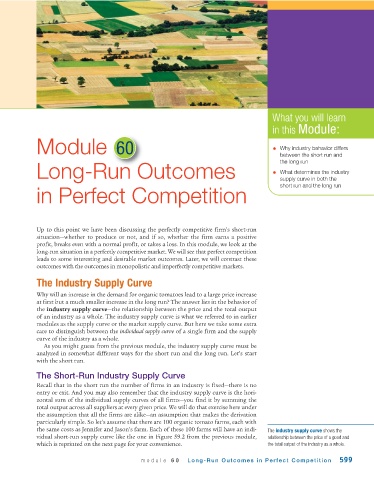Page 641 - Krugmans Economics for AP Text Book_Neat
P. 641
What you will learn
in this Module:
Module 60 • Why industry behavior differs
between the short run and
the long run
Long-Run Outcomes • What determines the industry
supply curve in both the
short run and the long run
in Perfect Competition
Up to this point we have been discussing the perfectly competitive firm’s short-run
situation—whether to produce or not, and if so, whether the firm earns a positive
profit, breaks even with a normal profit, or takes a loss. In this module, we look at the
long-run situation in a perfectly competitive market. We will see that perfect competition
leads to some interesting and desirable market outcomes. Later, we will contrast these
outcomes with the outcomes in monopolistic and imperfectly competitive markets.
The Industry Supply Curve
Why will an increase in the demand for organic tomatoes lead to a large price increase
at first but a much smaller increase in the long run? The answer lies in the behavior of
the industry supply curve—the relationship between the price and the total output
of an industry as a whole. The industry supply curve is what we referred to in earlier
modules as the supply curve or the market supply curve. But here we take some extra
care to distinguish between the individual supply curve of a single firm and the supply
curve of the industry as a whole.
As you might guess from the previous module, the industry supply curve must be
analyzed in somewhat different ways for the short run and the long run. Let’s start
with the short run.
The Short-Run Industry Supply Curve
Recall that in the short run the number of firms in an industry is fixed—there is no
entry or exit. And you may also remember that the industry supply curve is the hori-
zontal sum of the individual supply curves of all firms—you find it by summing the
total output across all suppliers at every given price. We will do that exercise here under
the assumption that all the firms are alike—an assumption that makes the derivation
particularly simple. So let’s assume that there are 100 organic tomato farms, each with
the same costs as Jennifer and Jason’s farm. Each of these 100 farms will have an indi- The industry supply curve shows the
vidual short-run supply curve like the one in Figure 59.2 from the previous module, relationship between the price of a good and
which is reprinted on the next page for your convenience. the total output of the industry as a whole.
module 60 Long-Run Outcomes in Perfect Competition 599

